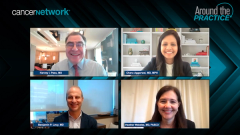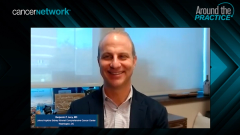
Future Perioperative Strategies in Non-Small Cell Lung Cancer
Before closing out their discussion on non–small cell lung cancer, experts share excitement for possible improvements in the setting of perioperative therapy.
Episodes in this series

Transcript:
Charu Aggarwal, MD, MPH: Harvey, with the growing presence of medical oncologists in the adjuvant management of patients, what’s your usual practice? Are you still following patient after resection, or are you predominantly letting medical oncologists see them on a routine basis with scans?
Harvey I. Pass, MD: That’s a terrific question. For every patient I operate on who doesn’t require postoperative adjuvant therapy, that patient is followed forever now that I’m not operating anymore. They’re still being followed, but I follow all my patients that I operated on. I look at their CT scans every 3 months for the first 2 years, every 6 months for the third year, and then yearly. Also, I study the disease. So if I don’t have that follow-up, I’m never going to find other biomarkers. But I’m different from others. If a patient has adjuvant therapy or stage IIIA, then my medical colleagues will follow those patients. I’ll know what’s happening.
Charu Aggarwal, MD, MPH: That’s great. In the last 5 minutes, I’d like to poll each of you. What’s the clinical trial or regimen that you’re most excited about in the near term, and what’s the biggest advantage or advance that we’re making? Heather, I’ll start with you.
Heather Wakelee, MD, FASCO: We have 4, 5, or 6 major trials in the perioperative setting that we have yet to see results from. In the neoadjuvant setting, we have 3. We’ll see when they come out, but they all gave neoadjuvant immunotherapy—pembrolizumab, atezolizumab. They’re all pending, but they also gave adjuvant. When we use both strategies, it’s going to be important to see what matters or how much we can add if we do it altogether. For adjuvant, as we look at the upcoming studies, including ANVIL with ECOG-ACRIN, we’re going to plug the cooperative group systems. That’s going to be critical to understanding it altogether.
One thing we haven’t talked much about today is the role of ctDNA [circulating tumor DNA] and other biomarkers. To me, we want to get to a state where we’re curing as many patients as possible but treating as few as possible if that makes sense. There are still patients who’ve been cured with surgery. They’ve always been patients cured with surgery, so we don’t want to treat those patients with additional therapy, which is going to give toxicity. How do we determine who’s already cured and who doesn’t need anymore? How do we separate them so they don’t need extra toxicity from the people who do need more? For the people who need more, how much do they need and how long do we treat them for? These are the questions that are going to be up to us to answer because it’s not necessarily in the best interest of pharma.
There are some very patient-advocate-minded folks as well, but it’s going to be cooperative group systems that try to ask us questions about how can we pull back. We want to cure people. We’re still focusing on more is better because we’re trying to cure, but once we get to a point where we’re curing more, how do we scale back? I think ctDNA and other markers of that nature, when they get sensitive enough, are going to be what we’re heading to. I’m so excited about that.
Charu Aggarwal, MD, MPH: I couldn’t agree more. That’s the space we need to explore and find outpatients who can potentially skip therapies and who adequately need more. Ben, same question for you: what are you most excited for?
Benjamin P. Levy, MD: Heather took the wind out of my sails with the ctDNA answer.
Heather Wakelee, MD, FASCO: I’m first.
Benjamin P. Levy, MD: I’ll add to it a little. You stated everything eloquently. I look forward to the new adjuvant genotype-directed therapy trials, like the LCMC4. We talked a lot about neoadjuvant chemotherapy–I/O [immuno-oncology] and neoadjuvant I/O, but there are huge efforts looking at neoadjuvant targeted therapies. To see how this helps patients will be really important. The issue about ctDNA is exciting. It’s confusing to answer this question. We’re going to need some observational data, from patients with stages II and III who don’t get adjuvant chemotherapy, and look at how they perform to answer this question. Whether we can do this or not will be tough. We’ll need some brave souls or people who don’t want our large efforts to look at patients who are resected stage II and III, who are ctDNA negative and then followed. Then we can see if this is truly an accurate molecular surrogate for outcome. That trial is going to be hard to design. Who’s going to randomize a patient who’s stage III with no ctDNA to an arm with no adjuvant chemotherapy? I look forward to seeing what happens.
I’ve learned a lot over the past few months. We’re wrestling with this as well, but it will be important. What ctDNA may do is, let’s say we have a design trial where you give adjuvant chemotherapy. If you’re still persistently ctDNA positive, you add immunotherapy or you don’t. That may be a way, but deciding who and who won’t get chemotherapy based on a ctDNA analysis, either as a onetime event or longitudinal, may be a little difficult.
Charu Aggarwal, MD, MPH: We’ll carefully have to think about how these trials are designed, but there’s definitely a need for that, as we’ve discussed. Harvey, you have the final take on this. What are you most excited about in lung cancer?
Harvey I. Pass, MD: For me, it’s the question of early stage patients: who recurs and who doesn’t recur. We have ways that we can explore this in the later-stage situation. I’m a mermaid guy, so I agree with Heather that having a trial that’s incorporated that is terrific. For early lung cancer, it’s difficult with many companies using fragmentation and ctDNA, and trying to figure out how to get more sensitive. For the 10% to 15% of patients who have stage IA disease who recur with the bad disease, we have to figure out either local, regional, or systemic. My mantra, which I’m excited about, is using different ways of digital spatial profiling to figure out who those bad actors are while using blood-based assays to then figure out which ones are the most sensitive. That’s the exciting part of early stage. I’ve got 3 phenomenal experts here who are late-stage mavens. I shouldn’t be concentrating on that, so I’ll concentrate on the early stage stuff.
Charu Aggarwal, MD, MPH: This was terrific. Thank you so much, Drs Levy, Pass, and Wakelee for joining us in this lively discussion on the treatment of non–small cell lung cancer brought to you by CancerNetwork®. I learned a lot with this discussion. I’d like to thank our viewing audience. We hope you found this discussion as helpful and informative as I did. Hopefully it was beneficial to your clinical practice. Thank you, everyone. See you again later.
Transcript edited for clarity.
Newsletter
Stay up to date on recent advances in the multidisciplinary approach to cancer.


























































































